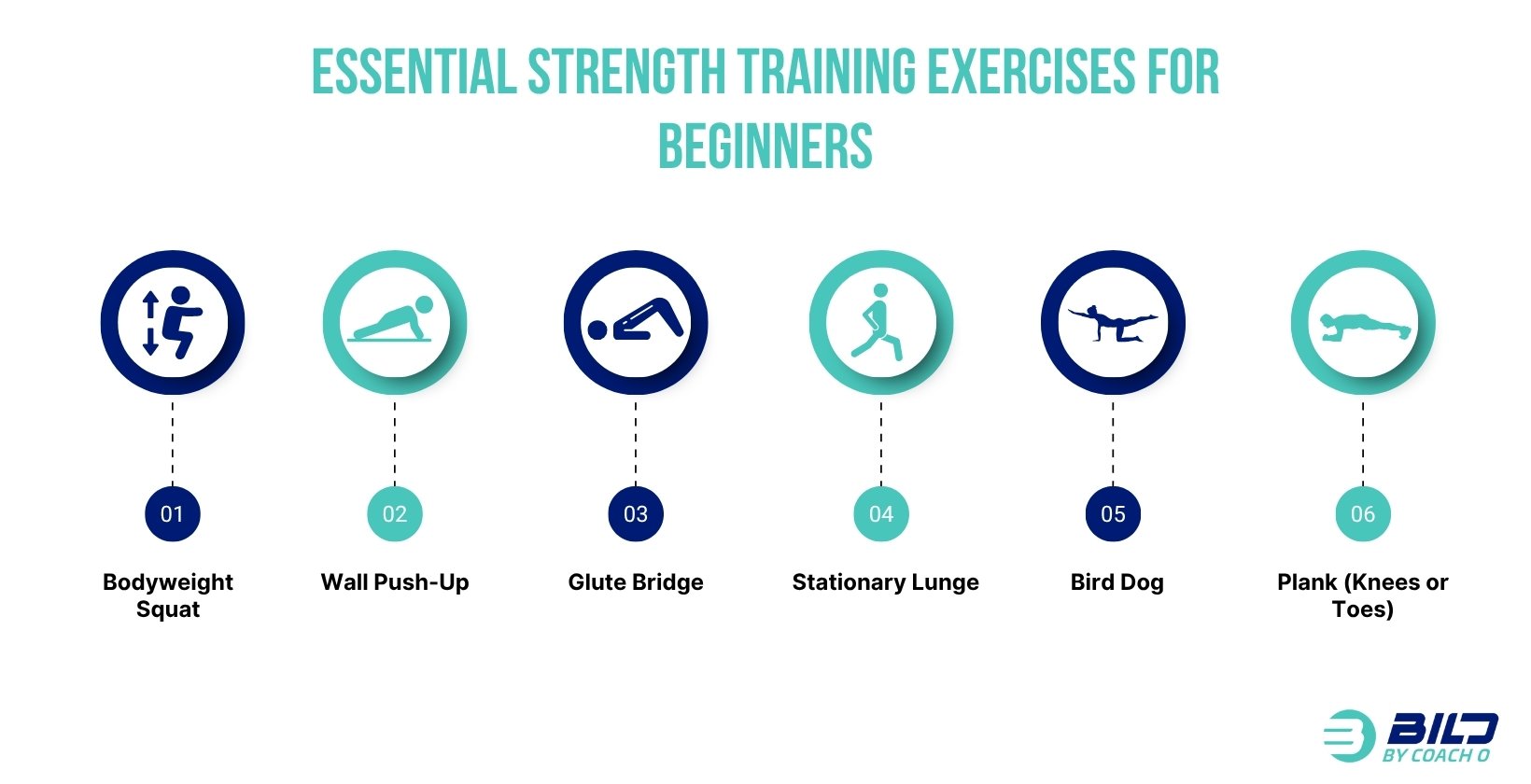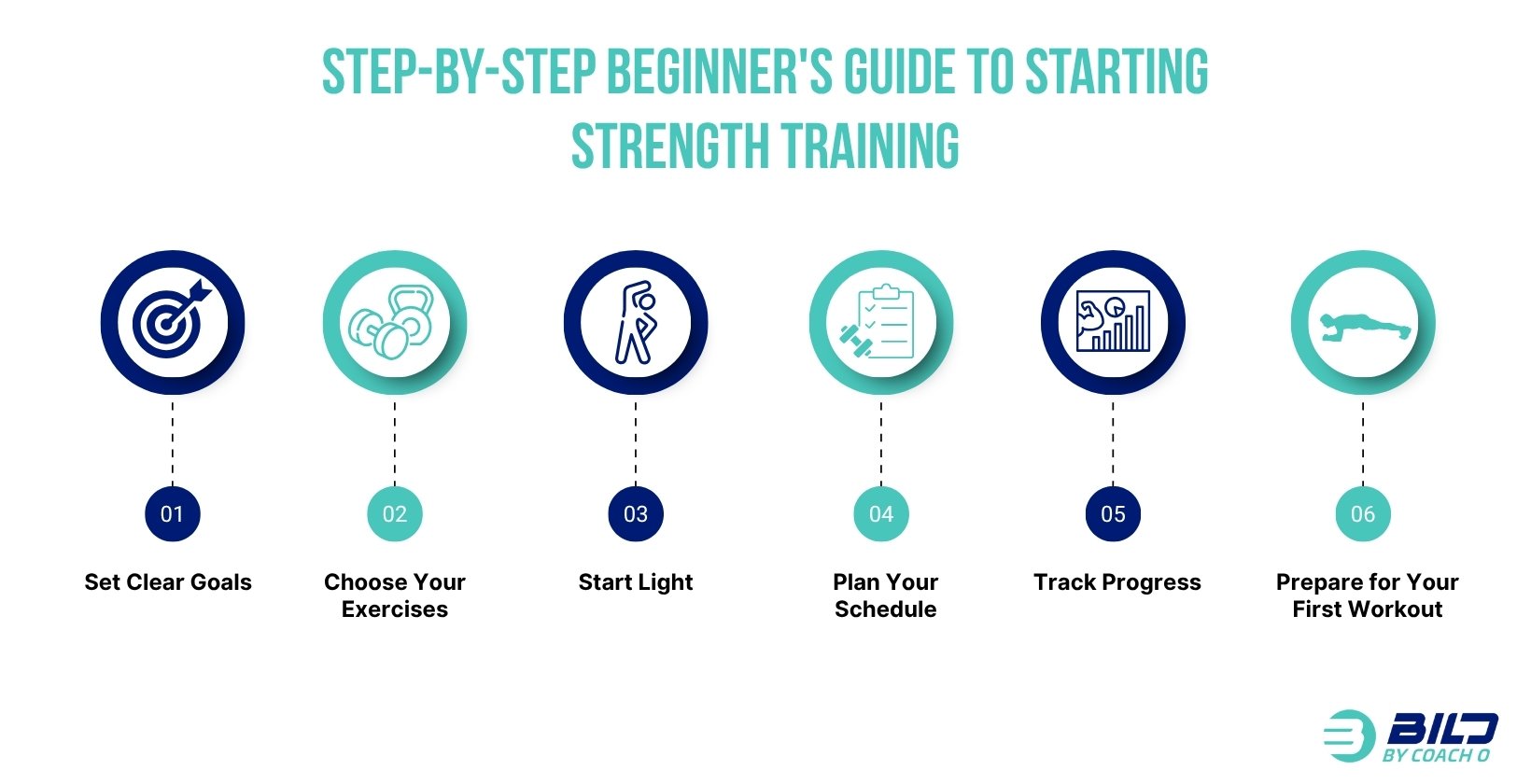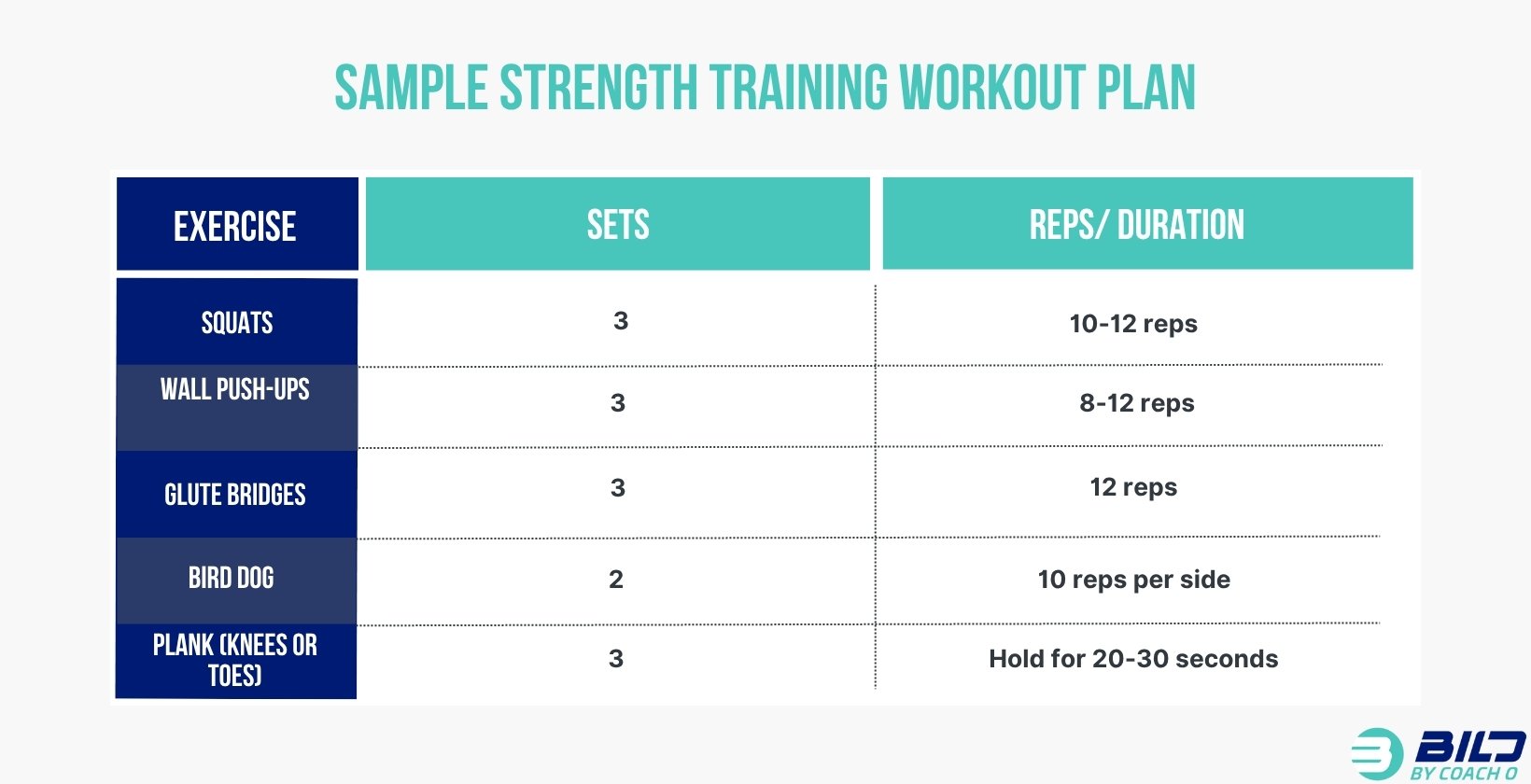Strength training for beginners by Coach O in Naples FL is the bomb! Embarking on a new fitness journey can feel exciting and a little overwhelming. If “strength training” sounds intimidating, this guide will change that.
It’s simply using resistance to strengthen your muscles and improve your body’s endurance. For beginners, it’s a great way to build muscle, improve health, and boost confidence, even if you’ve never worked out before.
We will walk you through everything you need to know, from what strength training is to how to perform basic exercises and structure your first workouts. You can start at home, at the gym, or somewhere near you.
What Is Beginner Strength Training and Why Should You Start Today?
Strength training, also known as resistance training, involves exercises that improve muscular strength and endurance. It works by contracting your muscles against external resistance, from your own body weight, dumbbells, resistance bands, or machines.
With a clear definition of strength training in mind, let’s explore its benefits. For beginners, strength training offers three core benefits: it helps you perform daily activities more easily, improves your body composition (more muscle, less fat), and promotes long-term physical vitality. It’s not about becoming a bodybuilder; it’s about becoming a stronger, more capable version of yourself. Starting is simple, accessible, and effective for every fitness level.
Strength Training for Beginners in Naples FL: What are the Benefits? Hint: There are Many!
Starting strength training brings transformative physical benefits, including increased muscle strength, improved bone density, and a faster metabolism, making daily tasks easier. Mentally, it boosts mood, reduces stress, and builds confidence, directly impacting your energy and mindset from the very beginning.
These advantages work together to upgrade a beginner’s lifestyle, fostering long-term physical capability and mental resilience. Explore these changes further in our complete guide on the benefits of strength training for beginners.
Getting Started with Strength Training: Foundations for First-Timers
Before you lift your first weight or do your first squat, learning a few foundational principles of strength training sets you up for both safety and success.
The Importance of Proper Form to Avoid Injury
Correct form is essential for safe and effective strength training. It helps you activate the right muscles and significantly reduces injury risk. Poor form can limit progress and lead to pain or setbacks. Always use controlled, deliberate movements instead of focusing on lifting heavier weights.
Understanding Warm-ups and Cool-downs
A 5-10 minute warm-up prepares your body for strength training by improving mobility and circulation. Include light cardio and dynamic stretches (e.g., arm circles). A 5-10 minute cool-down aids flexibility and recovery through static stretches (hold 15-30 seconds) for the muscles used.
Why Beginners Don’t Need to Lift Heavy Weights to Get Results
You don’t need heavy weights to see results as a beginner. Mastering proper technique and training consistently with lighter resistance is enough to build muscle growth and strength. Start with bodyweight or light dumbbells. This builds confidence and creates a solid, safe foundation for future progress.
Essential Strength Training for Beginners Exercises
For beginners, starting with simple bodyweight exercises helps build proper form and foundational strength. These low-impact, joint-friendly movements require no equipment and are effective for training at home or easing into a gym routine.
Start with these 6 beginner-friendly strength exercises:
- Bodyweight Squat: Stand hip-width apart, bend your knees, and lower your hips as if sitting in a chair. Keep your chest up and your heels grounded.
- Wall Push-Up: Stand an arm’s length from the wall, hands shoulder-width apart. Lower your chest toward the wall and push back up.
- Glute Bridge: Lie on your back, knees bent, feet flat. Lift your hips by squeezing your glutes. Avoid arching your lower back.
- Stationary Lunge: Step forward, lower both knees to 90 degrees, and return to start. Use a chair for balance if needed.
- Bird Dog: From a tabletop position, extend the opposite arm and leg. Hold briefly, switch sides, and keep your core engaged.
- Plank (Knees or Toes): Start in a push-up position on your forearms on the ground. Maintain a straight line from your shoulders to your hips while engaging your core.
These beginner strength training exercises build a solid foundation without equipment and prepare your body for more advanced routines.

How to Structure Strength Training: Sets, Reps & Weight for Beginners
When building a strength training schedule for beginners, it’s important to understand how workouts are organized.
- A rep is one complete movement of an exercise.
- A set is a group of reps performed back to back.
- Weight refers to the resistance used to make each rep challenging, especially in exercises like squats or dumbbell presses.
If you’re unsure about how many sets or how much weight to use, refer to the tips below.
How Many Sets and Reps Should Beginners Do?
For most upper body strength training for beginners in Naples FL, starting with 2 to 3 sets of 8 to 12 reps per exercise builds strength and prevents early burnout. This range helps develop muscular endurance while reinforcing proper form, especially with bodyweight or light resistance movements.
If you’ve been active recently or feel ready to progress, gradually increase to 3 to 4 sets, ensuring good form and allowing full recovery between sessions.
Choosing the Right Weight for Beginners
In any effective strength training for beginners program, selecting the right weight is essential for progress and injury prevention. Choose a weight that feels challenging during the final 2 to 3 reps of each set but still allows for clean form. If reps feel too easy, the weight is too light; if your form breaks down early, it’s too heavy.
For exercises like dumbbell presses or rows, most beginners start with 5 to 15 lb weights, adjusting based on control and fatigue. Focus on form and consistency, and increase resistance gradually as you gain strength.
Start Your Strength Training Journey With Our Free Intro Session
Understanding Progressive Overload for Beginners
Progressive overload refers to gradually increasing the challenge of your workouts by adjusting the weight, reps, sets, or tempo. Without this progression, your muscles adapt and stop growing, resulting in plateaus in your fitness journey.
For beginners, applying progressive overload with small, consistent changes is both safe and effective.
- Add 1–2 reps each week.
- Increase the weight by a slight amount every 2–3 weeks.
- Add 1 extra set when a workout begins to feel too easy.
This steady progression supports long-term strength gains and helps reduce the risk of injury.
The FITT Principle for Strength Training for Beginners in Naples FL: How to Structure Your Beginner Workouts
The FITT principle (Frequency, Intensity, Time, and Type) helps beginners create a structured, effective routine for full-body strength training. It balances how often and how hard you train with the right types of exercises, such as bodyweight movements or compound lifts.
How Often Should Beginners Strength Train?
For beginners, strength training two to three times a week builds strength and allows for proper recovery. This frequency supports muscle growth, reduces the risk of injury, and improves consistency. Rest days are crucial for muscle recovery and repair. As you progress, increase frequency or add targeted sessions, such as push/pull or full-body, based on your goals.
How to Adjust Frequency and Intensity Based on Goals
As you advance in strength training, adjust frequency and intensity according to your fitness goals.
- For muscle growth, train 3 to 4 times a week at moderate to high intensity.
- For general fitness or fat loss, aim for 2 to 3 full-body workouts using lighter weights and higher reps.
Lower training volume to support recovery and avoid burnout if soreness persists or energy levels drop.

Actionable Guide: How to Start Strength Training Today
If you’re wondering how to start strength training for beginners in Naples FL, the key is to keep it simple, structured, and sustainable. You don’t need a gym or advanced equipment, just a clear plan, consistency, and a few beginner-friendly movements, especially for training at home.
Step-by-Step Beginner's Guide to Starting Strength Training
Use this simple checklist to begin your strength training journey with confidence:
- Set Clear Goals: Define your objectives, whether building strength, toning muscle, or improving endurance.
- Choose Your Exercises: Select 4-6 beginner-friendly full-body movements, such as squats, push-ups, lunges, and planks.
- Start Light: Use body weight or light weights to focus on control and form before adding resistance.
- Plan Your Schedule: Begin with 2-3 sessions per week to allow for full recovery and adaptation.
- Track Progress: Record sets, reps, weights, and how you feel to monitor improvements over time.
- Prepare for Your First Workout: Wear comfortable clothes, hydrate, and warm up for 5-10 minutes.
Stay consistent and patient; your body will adapt, and each small win will build momentum.
Celebrate small victories along the way!

Sample Strength Training Workout Plan
A beginner’s strength training plan can start with three full-body sessions per week, focusing on compound, bodyweight movements.
Here’s a sample workout:
Exercise | Sets | Reps/ Duration |
Squats | 3 | 10-12 reps |
Wall Push-ups | 3 | 8-12 reps |
Glute Bridges | 3 | 12 reps |
Bird Dog | 2 | 10 reps per side |
Plank (Knees or Toes) | 3 | Hold for 20-30 seconds |
Rest 30–60 seconds between sets and prioritize proper form over speed or load.

Tracking Your Progress
Tracking your strength training for beginners progress boosts motivation and supports the principle of progressive overload. Reviewing your past sessions gives you a clear sense of achievement and direction.
To get started, use a workout journal or a fitness app. For each session, log:
- Date
- Exercises performed
- Number of sets and reps
- Weight/resistance used (if applicable)
- Energy levels or how you felt
This process helps you see trends in your strength gains and know when to increase intensity safely.
Beginner-Friendly Gym Equipment for Strength Training
When starting strength training at the gym, beginners don’t need to use every machine. Focus on basic equipment such as dumbbells, kettlebells, and resistance bands. These tools are versatile, help you build proper form, and facilitate smooth progress into more advanced lifts as your confidence increases.
For home use, beginner-friendly equipment includes a yoga mat, light to medium dumbbells, and a resistance band. This setup supports full-body training and encourages consistency. Focus on movement quality before investing in heavier or more complex gear.
Top Beginner Mistakes in Strength Training (and How to Avoid Them)
To get the most out of your strength training for beginners routine, it’s important to avoid common mistakes that can lead to injury or stalled progress.
Here’s what to watch for, and how to train smarter:
- Skipping warm-ups: Always start with 5–10 minutes of light movement to prepare your muscles.
- Using poor form: Prioritize control over speed; consider filming yourself or asking a coach for feedback.
- Lifting too heavy, too soon: Start with manageable weights to develop proper technique and prevent strain.
- Neglecting rest days: Recovery is when muscles repair and grow; schedule rest between workouts.
- Inconsistent tracking: Log sets, reps, and weights to monitor progress and apply progressive overload.
Being aware of these common errors helps you avoid setbacks and stay consistent as your strength builds over time.
Struggling to Start? Join BILD by Coach O for Personalized Coaching
Starting strength for beginners can feel overwhelming. With conflicting advice, inconsistent results, and low motivation, it’s easy to lose direction before progress begins. Many beginners face these same challenges.
At BILD by Coach O, we simplify strength training for beginners with expert-led coaching, clear programming, and a supportive fitness community built right here in Naples.
Ready to start strong? Call us at 239-438-1147 to join BILD today for personal guidance, structured support, and real results, no matter where you’re starting from.
